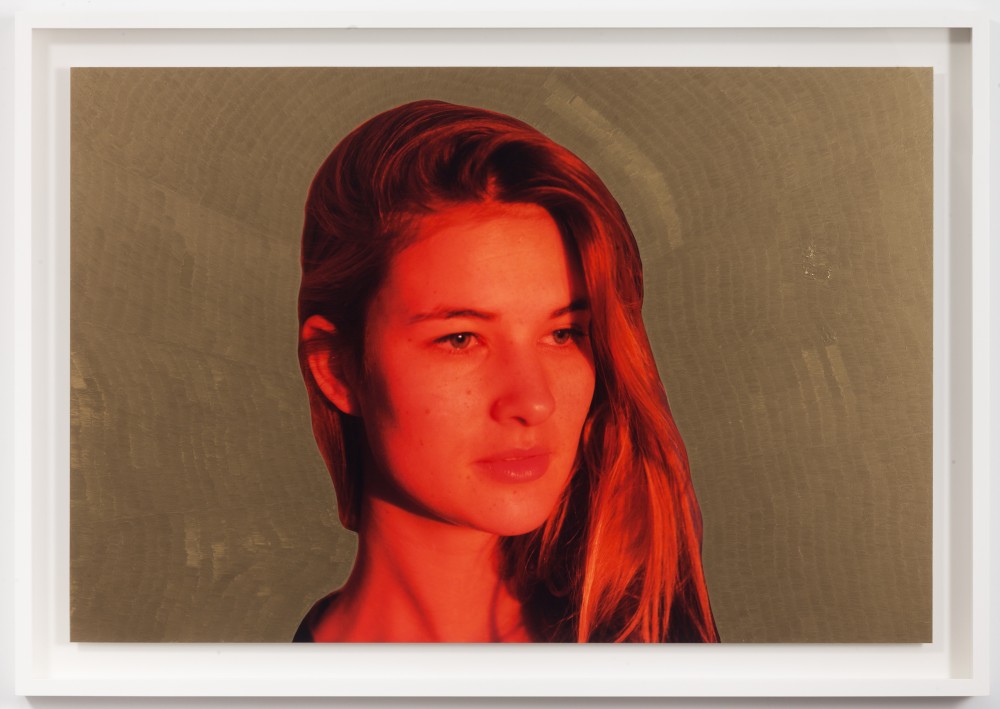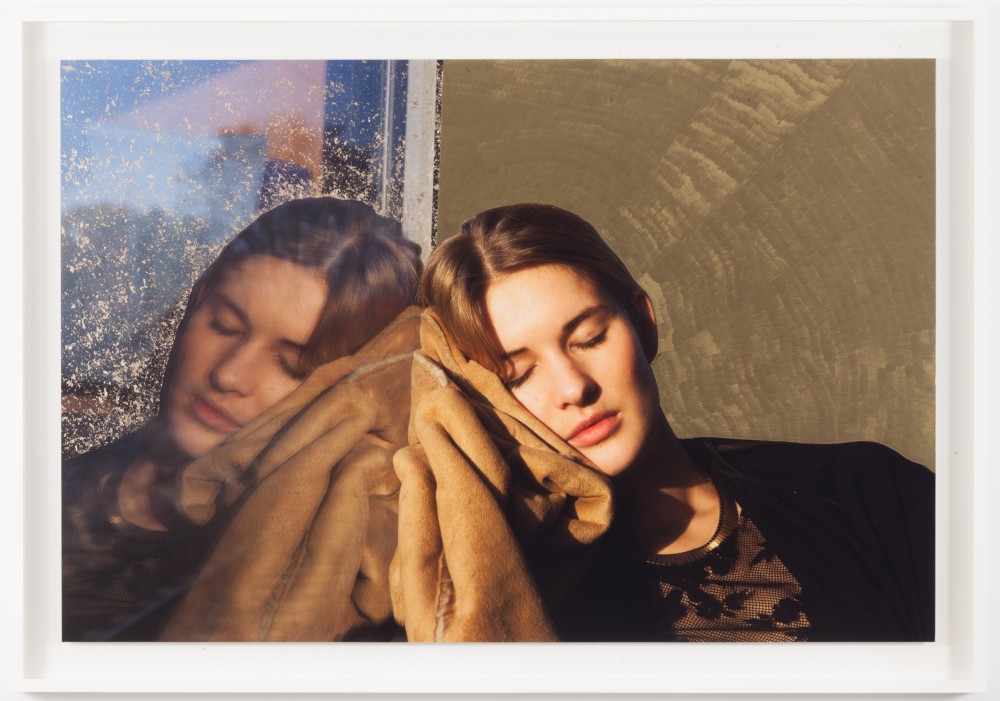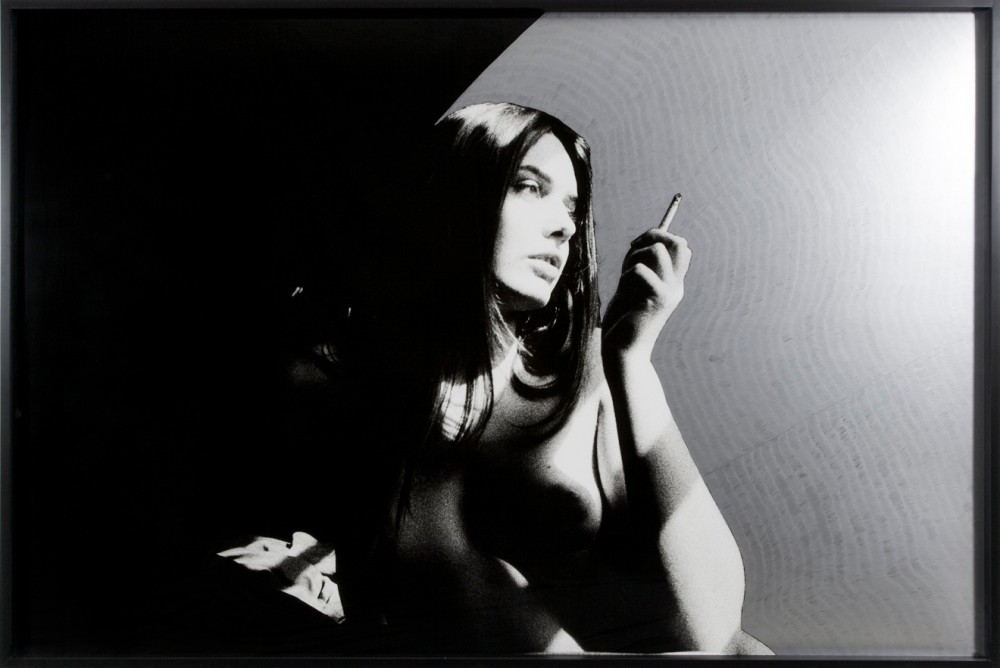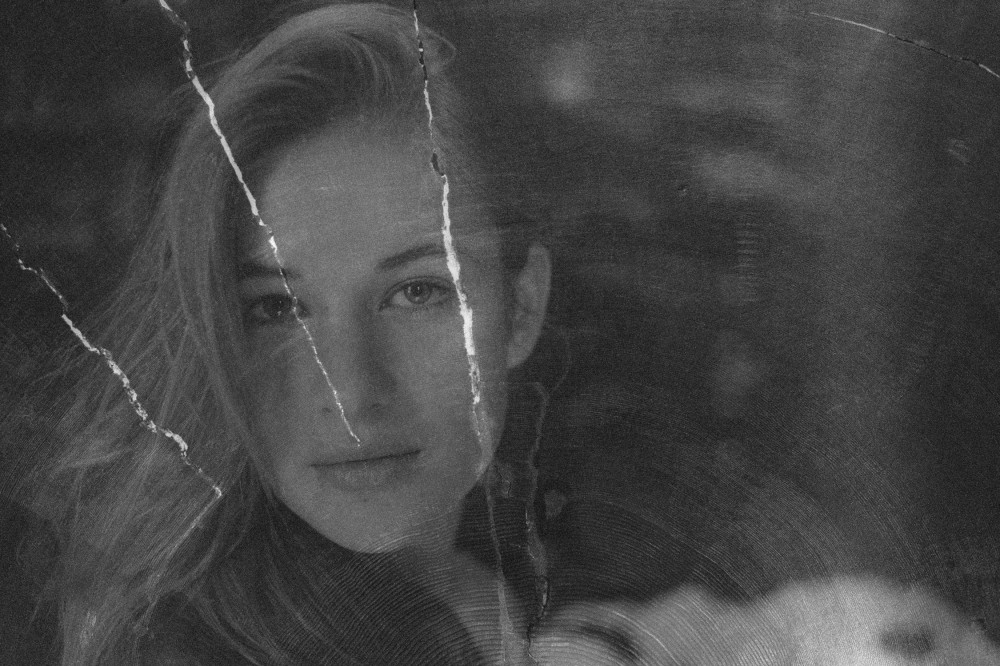Andrea Blanch: Did you ever think about doing a film?
Slater Bradley: Yes.
AB: Is that coming?
SB: No. I never found a script. I've tried, it's definitely been a goal of mine. I know a lot of people in the film industry, and the sacrifices that you have to make, and the egos you have to balance. It's not something I really try to aspire to. Although someone like Steve McQueen is a perfect example of an artist who has actually made the transition.
AB: Do you feel that you need to have your own script?
SB: I've always been waiting for someone to put the script in my lap and say, “Slater, here's what you need to do.” And nobody ever has.

AB: You use gold a lot in your work. Gold leaf, gold marker, gold this, gold that. What's the attraction?
SB: I use some silver too. But it's funny, nobody's really ever asked me that, and I sort of knew you were going to ask me that, and, well, growing up I did go to an Episcopalian school. A cathedral school in San Francisco, and the cathedral had a certain kind of imagery. I had that Catholic light. I use gold as a signifier of value. Gold and silver markers are permanent. Silver is more easily identifiable with the silver screen in cinema. Gold more of a sort of antiquated Visantium type of past era thing. Because it could border on being really vulgar.
AB: Tell me about the show that’s about to open at Sean Kelly Gallery.
SB: It’s the culmination of a body of work about Alina. It’s also the girl in The Last Goodbye picture.
AB: When did you say goodbye to her?
SB: I’ve been trying not to get so personal about the whole thing. The way I think about reality, there’s many different levels – Alina was always in my consciousness because the work is so pure in that way. It’s really difficult for me to say. It was this intense, crazy, whirlwind, hurricane that came into my life, blew through everything and brought about a lot of these deep subconscious feelings and trajectories that had been present for a long time, and which I had ignored. The piece originally was a structured photography project based on Charlie Ray’s most beautiful woman in the world. He was my teacher and I was very obsessed with this piece that he did for Parkett magazine in 1993 where he took Tatjana Patitz’s portraits. He had this supermodel, and he was depicting her as the “girl next door.” I think this piece is very genius, because this is essentially what Twitter and social media has done. But in 1993, this idea was extraordinary. I saw Alina one day at a party in Williamsburg, I thought, “This is the girl I can remake this piece with.” And I was thinking a lot about Antonioni’s films and Monica Vitti. I’m very attracted to women with these sort of Capricorn-rising faces. These sort of tragic, lost women. When I met her she was very young, and lost. I met her, and said, “Let’s do this project,” and in the process my heart cracked open, and it was like: “I’m totally in love with you, and I’ll do whatever it takes.” You know, at a certain point you make art for so long, you’re constantly giving and giving, and this was the first time I could make something happen. And then it was the difficult process of maintaining a long-distance relationship. It got to be too grueling, and it dissolved. But I learned a lot about unconditional love during the process. No matter what somebody says, no matter how hardcore it is, you continue to love them and support them and do whatever you can. That was the big lesson for me. I try and practice it every day. She’s been the catalyst of this huge transformation in me from New York to Berlin.

AB: So this project is the culmination of this entire experience?
SB: Well, I did the show in Madrid. It’s one of those things where you’ll make a body of work and it will generate momentum, and people will just really like the work. I didn’t even really know why I was making this stuff. Then I got offered the show in Madrid, and there was a paradox to it, between these time-consuming marker drawings, very Saturn, very task-master; I just sat there, and I had to go into these very deep, meditative states. And I could telepathically communicate, I felt, with her. This process made me think of La Jetée, being strapped down and fixated by a memory. Taking yourself mentally and telepathically to that place, and that’s what I did for a year. I’d hear from her every once and a while, and I would check the astrology charts and figure out what was going on with her world. It was really a great way for me to feed my interest in astrology. I literally thought I was going to die doing these pieces. They would never stop. And finally this show is a way for me to let go. It’s been a process of letting go and in the true La Jetée narrative, she was going to go see the show in Madrid. But in the morning, when I was getting ready to go pick her up at the airport, she calls me and says, “I’m sick, I can’t go.” There was some hardcore, karmic stuff happening that day. I said, “I really have to let go, because it will kill me.” I think practicing unconditional love is an amazing thing to do, but I think you have to do it for yourself, as well.
AB: What do you think about the role that fantasy plays in long distance relationships?
SB: One of my pieces in the show is called Saturn Trine Neptune, which is the idea of taking the illusion, the dream, and bringing it down to reality. I think our realities could never exist together, because we’re at different stages of our lives. But we could go to this place where she could be my muse, and I could photograph her endlessly. And this place, that could have been the reality, but it was never really sustainable in the real reality. Meaning it was just a fantasy. I think that those moments are more real in this reality, because I exist in my imagination. And as an artist it’s my job to exist in my imagination. That’s what I get paid to do. I have a great sort of conscious-subconscious alignment so I can really manifest things. If I have an idea of an art piece I want to create, I can turn it into a reality. You can never manifest a relationship, at least I can’t. You have to learn to let go. I think more about this project as a celebration and remembrance of true love. Everybody should celebrate it, because it's amazing when it comes into your life.
AB: You talk about things that become obsolete, and how you have to move on. Is there any medium that takes preference over others left behind or isn't as present as they used to be for whatever reason?
SB: Well, I was obsessed with Kodachrome. The film went out of stock in 2006 and they stopped producing it in 2009. This idea that I can be obsessed with film stocks, degenerating video and aesthetics that look like that which no one cares about come from a medium. Now there's just an app that makes it look like that. Ten years ago I would intentionally degrade all my video work, the surface of the video work and ironically it just looks like the crappy videos people send to each other on their phones. It's astonishing to me to think that in ten years of working, nobody had ever seen this aesthetic. Now, it’s a very ubiquitous present thing, so that's what I talk about with technology or working with video or film, or photography. A lot of it for me was trying to find aesthetics that weren't really prevalent in culture, and now it seems like there is an aesthetic for everything all the time. But if somebody is going to survive it has to get you on a certain level besides aesthetic.

AB: You were the youngest person ever to have work exhibited in the Guggenheim. Have you maintained that level of excitement, anticipation, work, since that moment in your career? I imagine it puts a lot of pressure on you. How did you deal with all that?
SB: I went to therapy for six years. [laughs] No, that was extraordinary because, I kid you not, in college I had taken a picture of the Guggenheim and we had a scholarship program and I won the scholarship. I put the picture up of the Guggenheim and the teacher asked, “Why is this picture here?” I said, “Because that's where I'm going to have a show.” They all laughed at me. And of course, who's this arrogant kid think he is? So when it happened, which was mind blowing, it was realizing your dream. I was like, “What do I do now?” And that's when I had to spend an intense period of really going deep within and working on myself for a long, long time. It put me in a therapist office, but it was good. That's where a lot of the work comes from. But, I'm a Capricorn, the goat always climbs the mountain.
AB: Can you explain the birth of your doppelganger project? What inspired the idea and the methods of producing the images?
SB: A lot of my life is just paying attention to spirits communicating with me and these signs. In 1999 I was very obsessed with Nabokov's Lolita. There are a lot of illusions of doppelgangers. I think at the time The Talented Mr. Ripley came out, which is one of my favorite films and that's a doppelganger. Matt Damon is the doppelganger. It was on my mind and I just started hearing about this guy who looked like me in the city – and again, what's really interesting about this, in the popular vernacular of 2000, nobody knew what a doppelganger was. I would have to explain to people what the project was. And by 2006 Facebook was doing doppelganger things. It's amazing how the doppelganger thing always goes in and out of culture, depending on the anxieties of the time, like war, or spying, or 9/11, or WWII, McCarthyism, Sherlock Holmes, these kinds of things. So, it all depends. Now I'm happy to be past that project. So, sun in the seventh house of my relationships. I naturally like to make these projects about these relationships. I like to do these projects where this person becomes everybody and nobody. They become a stand in for a projection device. Alina, she has this chameleon-like face. She can look like five different girls, and I like this idea; she becomes a stand in, and a projection, filtered.
AB: In your most recent work, Sequoia, you deal with notions of reflection, memory and the vague meshing of truth and fiction. What interests you about grabbing moments from the past, and with that, creating something new that takes on a different meaning?
SB: It's an obsession with the past and archetypes. I lead with my emotions. What's really interesting about this show, it's called A Point Beyond The Tree, the sequoia tree, and time, the guy from La Jetée, he comes from outside the time, and I was thinking that with these marker drawings that I do, it's about taking out the background, which makes the person iconic, but also removes them from time and space. They essentially become timeless. I think the way we think about time is wrong, especially since I've been studying astrology. It's energy, and energy comes back and hits you in different ways and time repeats.
AB: Do you consider yourself a romantic?
SB: Yeah. You know what's interesting, one of the reasons I got so into astrology . . . they said, “You have Chiron in your tenth house, you have a wound and you have to share it publicly and you have to let the public eat your heart out. And that's it, that's what you do.” When they said that to me I thought, “This work is so personal. Why do other people make work that's cold, you can't tell who’s making it, and why do I have to be the one who has to die, all the time, consistently?”
AB: So this issue coming up is about fantasy. What's your personal fantasy at this moment?
SB: To be able to move objects with my energy, telekinetically. And then you know, live happily ever after in Berlin. I really want a kid, and that's a great place to have children. Hopefully I can meet the right one and settle down.


